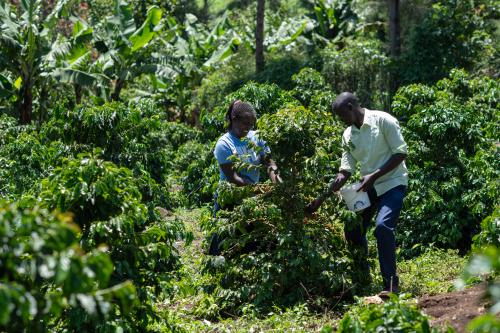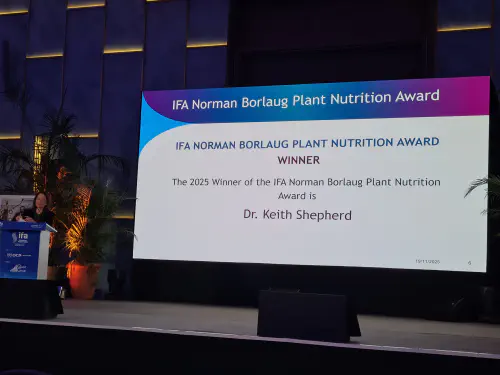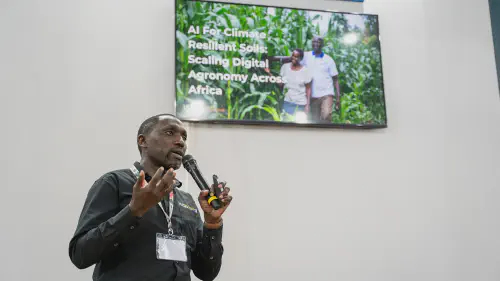For decades, Africa’s smallholder farmers have produced only a fraction of the yields seen elsewhere. Despite billions spent on seeds and fertiliser, productivity has stagnated - not for lack of effort, but because most farmers lack access to one thing the rest of the world takes for granted: field-specific agronomic advice.
That advice works. Traditional agricultural extension, where agronomists visit farms in person, can double or even triple yields - but it typically costs $30–60 per farmer per year, a figure that makes continental coverage impossible. iSDA has found a cheaper way. Our Virtual Agronomist uses artificial intelligence to deliver site-specific recommendations through a simple chat interface for about $1 per farmer per season. Already serving more than 250,000 farmers, it has achieved yield increases of up to 60 per cent. If those results scale, Africa’s next agricultural revolution could be digital rather than mechanical.
You come from a software and maths background, not agronomy. What first drew you to this field?
When I first joined iSDA, I asked Keith Shepherd and Jonathan Crouch, our founders and expert agronomists, what kind of yield improvements were realistic. I expected incremental results - five or ten per cent, the sort of gain you might get from a better algorithm. When they told me it could be fifty to a hundred per cent, I was shocked.
They explained that many African farmers start from such a low base of soil fertility that they sit at the very bottom of an S-shaped yield curve. The first step up is enormous. That was the moment I realised this wasn’t about marginal optimisation - it was about unlocking human potential trapped by lack of information.
You’ve said that, as a child of the 1990s, the internet shaped how you think about knowledge. How does that connect to what you’re doing now?
Back then, “knowledge wants to be free” was our creed. The idea that anyone, anywhere, could access information that had once been locked away was world-changing.
When I saw that the same principle could apply to farming - that the right advice could literally double a family’s yield - it felt like a moral obligation. Knowledge, when made accessible, can build prosperity for millions. I saw an opportunity to bring that internet-era optimism to something tangible: helping farmers grow more food, earn more and live better.
Why has Africa’s agriculture lagged behind the rest of the world?
The short answer is that Africa missed its Green Revolution. In Asia, breakthroughs such as dwarf wheat and rice removed genetic limits and unleashed huge yield gains. Africa’s challenge is more tangled: degraded soils (they are the oldest continually farmed on Earth), fragmented plots, communal land rights that hinder consolidation, diverse land histories and mounting climate shocks. There isn’t one miracle seed or fertiliser to fix all that. Each farm needs its own solution.
Across sub-Saharan Africa, average cereal yields hover around 1.8 tonnes per hectare, compared with nearly 4 tonnes globally, according to the UN Food and Agriculture Organization (FAO) and Our World in Data. That gap has barely shifted in two decades.
Of those challenges, which is the biggest?
Soils, without question. Baseline fertility is extraordinarily low. African farmers haven’t had the century of nutrient build-up that northern farms enjoyed. Crops remove whatever nutrients are applied, so fertility declines year by year.
The uncomfortable truth is that Africa needs more fertiliser, not less - but used intelligently and precisely. That means long-term, targeted soil management combining both chemical and organic sources. Get that right and everything else follows.

You often compare Africa with China, where farms are smaller but yields are three times higher. What’s the lesson there?
China shows that small farms can be highly productive. The difference lies in the ecosystem around them: good roads, strong offtake markets, better logistics, higher digital connectivity. African farmers face far tougher conditions - less infrastructure, more variability, more rain-fed systems.
But the principle holds: small doesn’t mean inefficient. With the right support and smarter, localised decisions, smallholders can thrive. China’s experience proves that productivity doesn’t depend on farm size, but on knowledge and coordination.
What’s so powerful about site-specific advice compared with generic “best practice” guidance?
Generic advice has largely failed to lift yields. It’s too blunt. Farmers differ plot by plot - soil chemistry, cropping history, rainfall, pests, management. The same recommendation can be right for one field and wrong for the next.
There’s strong evidence that site-specific advice can raise yields by 40–70 per cent on average. Often only one or two factors limit a farmer’s performance, but they differ between farms and seasons. Identifying and solving those particular constraints is what changes outcomes.
Can you give an example?
Take two neighbouring maize farmers. To the eye their fields look identical. One yields two tonnes per hectare, the other four. The difference might be soil fertility, pest pressure or simply planting date.
Generic advice would treat them identically - “apply X bags of NPK in this district.” Our Virtual Agronomist sets different yield targets and recommendations. For the lower-yielding farm it might focus on plant spacing or weeding; for the higher-yielding one, on fine-tuning nutrient balance and return on investment. It’s not one prescription but a living, adaptive system.

You’ve called this “mass customisation”, a term more common in manufacturing.
Exactly. There’s so much variation farm to farm and farmer to farmer that the only scalable model is one that learns and adapts to each case. You can’t send millions of agronomists into the field, but you can build one intelligence that scales to millions of farmers. It’s the same principle that underpins modern AI: mass personalisation powered by data.
Large language models such as ChatGPT or Gemini are already used globally. Why not just rely on them?
We’ve tested them. They give directionally correct answers but aren’t practical for most farmers. They lack calibration - no awareness of local soils, fertiliser types or yield targets - and they’re inconsistent. Ask twice and you may get two different answers. Farmers notice that and lose confidence.
Some argue that reasoning models or reinforcement learning will solve this, but the data simply doesn’t exist. Agronomy depends on measured, local parameters - soil pH, organic carbon, cation-exchange capacity - and that data is scarce. Without it, global models can’t give truly site-specific guidance.
So what’s iSDA’s role in that ecosystem?
AI will soon be everywhere - on every phone, in every messaging app. Farmers will use those same tools like anyone else. Our role is to be the scientific engine underneath: the layer that provides validated, local agronomic intelligence to those systems.
Whether the advice comes directly from our own Virtual Agronomist or through another AI drawing on our data, the goal is the same: every farmer, everywhere, should have access to expert, tailored guidance.
What would success look like in twenty years?
If we succeed, Africa can be self-sufficient in food. Farmers will be more resilient to climate change, incomes will rise, and pressure to expand farmland into natural ecosystems will ease. Smarter farming, not enclosure - that’s the path to both prosperity and sustainability.
The UN projects Africa’s population to double by 2050, making it the only continent still growing rapidly. Without yield increases, the World Bank warns that food imports - already covering around 20 per cent of Africa’s consumption- will rise sharply, worsening trade balances and rural poverty. The stakes are enormous.
And if not?
Then food security will worsen. Many countries are already too dependent on imports, leaving them economically and politically vulnerable. But there are tipping points.
Take rice: a staple across the continent, often imported because Asian yields make foreign grain cheaper. Raise African yields just enough and the economics flip - local production becomes competitive, imports fall, and a cascade of positive change follows. That’s the opportunity we have.
Finally, what should readers take away?
That the potential is extraordinary - but it won’t realise itself. AI could revolutionise agriculture, but only if we act deliberately to fill the gaps the market will ignore.
Absent organisations like iSDA, global AI will skip over Africa’s smallholders. These farmers have little digital footprint and scant economic pull, yet they feed hundreds of millions. If we can give them the same intelligence revolution that transformed every other industry, we can change not only the yield curve - but the future of food.



